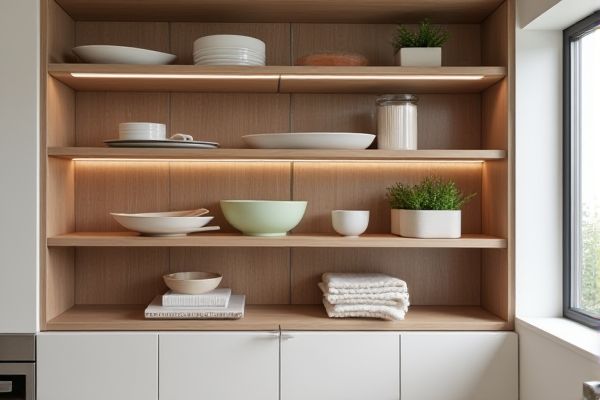
Stackable shelves maximize vertical storage space by allowing you to customize the height between tiers, ideal for organizing items of various sizes efficiently. Explore the rest of the article to discover how pull-out trays can also enhance accessibility and compare which option best fits your storage needs.
Table of Comparison
| Feature | Stackable Shelves | Pull-Out Trays |
|---|---|---|
| Accessibility | Items stacked, may require moving top items | Full access with sliding trays, easier reach |
| Space Utilization | Vertical space optimized, limited by shelf height | Maximizes depth and width, easy organization |
| Installation | Simple placement, no hardware needed | Requires hardware and installation effort |
| Cost | Generally low cost | Higher cost due to hardware |
| Durability | Stable but dependent on shelf material | Durable with quality sliding mechanisms |
| Ideal Use | Lightweight items, easy stacking | Heavy or frequently accessed items |
Introduction to Stackable Shelves and Pull-Out Trays
Stackable shelves maximize vertical space by allowing you to layer storage units, ideal for organizing items in cabinets or closets with limited height. Pull-out trays offer easy access to stored items by sliding out smoothly, making them perfect for deep cabinets and reducing the need to reach or bend. Both solutions enhance organization but cater to different storage needs based on accessibility and space utilization.
Functionality: How Each Storage Solution Works
Stackable shelves maximize vertical space by allowing you to layer items efficiently, improving visibility and easy access by simply reaching or lifting items on top. Pull-out trays operate on sliding mechanisms, enabling you to fully extend the tray for quick retrieval of stored goods without disturbing other items. Your choice depends on whether you prioritize compact vertical stacking or effortless drawer-like access for heavy or frequently used items.
Space Efficiency: Maximizing Storage Capacity
Stackable shelves enhance space efficiency by creating multiple vertical layers, allowing you to store more items within the same cupboard footprint. Pull-out trays maximize storage capacity through easy access to deep or rear items, reducing wasted space in back corners. Combining both solutions can optimize overall storage, making the most of your kitchen or pantry space.
Installation Process and Requirements
Stackable shelves require minimal installation, often just placing the units inside a cabinet without drilling or mounting, making them ideal for renters and quick organization. Pull-out trays demand more precise installation, involving mounting sliders or tracks to cabinet interiors, which may require drilling and alignment tools for smooth operation. The pull-out trays' hardware requirements and potential cabinet modifications contrast with the tool-free, flexible setup of stackable shelves.
Accessibility and Ease of Use
Stackable shelves provide enhanced vertical storage, allowing easy visibility and access to items by simply reaching or lifting them, ideal for organizing smaller spaces. Pull-out trays offer superior accessibility by sliding out smoothly, enabling users to retrieve items stored in the back without bending or reaching deep inside cabinets. Both solutions improve ease of use, but pull-out trays excel in ergonomic design for frequent access, while stackable shelves maximize space efficiency.
Versatility for Different Storage Needs
Stackable shelves offer superior versatility for different storage needs by allowing you to customize vertical space efficiently, accommodating items of varying heights and sizes. Pull-out trays excel in accessibility, providing easy reach to items stored at the back, ideal for frequently used goods or heavy objects. Your choice depends on whether maximizing vertical storage or enhancing accessibility aligns better with your organizational goals.
Durability and Material Options
Stackable shelves offer robust durability with heavy-duty metal or reinforced plastic options designed to support substantial weight without warping or bending. Pull-out trays often feature smooth-gliding metal or wood materials that provide long-lasting strength while allowing easy access, though they may require higher maintenance to avoid wear on sliding mechanisms. Both options vary widely in material quality, but metal stackable shelves typically outperform pull-out trays in load capacity and resistance to deformation.
Aesthetic Considerations and Design Styles
Stackable shelves offer a sleek, minimalist look ideal for modern and contemporary design styles, blending seamlessly into open cabinet spaces to maintain visual uniformity. Pull-out trays, with their functional handles and visible hardware, complement industrial or rustic aesthetics by adding practical charm and tactile appeal. Your kitchen or storage space can benefit from selecting shelves or trays that enhance the overall design theme while balancing accessibility and visual flow.
Cost Comparison and Value for Money
Stackable shelves typically offer a lower upfront cost compared to pull-out trays, making them a budget-friendly option for maximizing storage space. Pull-out trays, while generally more expensive due to their sliding mechanisms and installation requirements, provide enhanced accessibility and organization that can justify the higher price over time. Your choice depends on balancing initial cost savings with long-term convenience and durability, ensuring you get the best value for your investment.
Choosing the Best Option: Stackable Shelves vs Pull-Out Trays
Stackable shelves maximize vertical storage space by allowing multiple layers of items to be neatly organized, ideal for static or less frequently accessed belongings. Pull-out trays offer easy access to items stored deep within cabinets, providing better visibility and convenience for frequently used products. Selecting between stackable shelves and pull-out trays depends on the balance between maximizing storage capacity and enhancing accessibility in your specific space.
 homyna.com
homyna.com